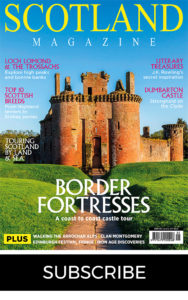MORE FROM SCOTLAND MAGAZINE
The history of tartan: A chequered history
As a major new exhibition on tartan opens in Dundee, we look back at the rise to prominence of this most Scottish of patterns. Discover the history of tartan here…
Tartan’s worldwide appeal is indisputable – from hotel rooms to palaces and stately homes, to catwalks and high street shop windows, this distinct pattern of stripes and checks is everywhere. It’s become so fashionable that the late Vivienne Westwood’s dying wish was that her funeral service be swathed in Harris Tweed MacLeod tartan – a wish fulfilled by Harris Tweed Scotland, whose owners Mark Grieg and wife Julie personally delivered the fabric to the English church hundreds of miles away.

But while tartan been appropriated by contemporary fashion designers and other cultures – the indigenous textiles of Indian Madras and East African Shuka cloth are said to have been influenced by it, and Japan is the second largest Scottish export market after the US, thanks largely to the tartan skirts of the Harajuku girls – it remains synonymous with Scotland. You only have to look at the kilts and shortbread tins that line Edinburgh’s Royal Mile or attend any Scotland-themed event (wherever it is in the world) to see tartan represented as a symbol of Scotland and kinship.
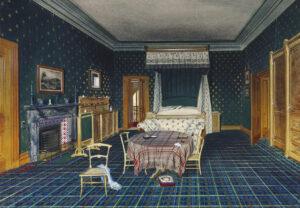
From 1 April 2023 to 14 January 2024, the Tartan exhibition at the V&A Dundee – the first major show of its kind in 30 years – promises to take a radical new look at this famous pattern, with over 300 objects from over 80 worldwide lenders, from Chanel and Dior to the Royal Collection, on display.
Celebrating five years since the opening of the V&A in Dundee, the very first V&A museum outside London, this is the first exhibition fully created and curated by the Dundee team and so while taking a forensic look at Scotland’s most famous pattern may seem like an obvious choice, the museum promises to be bold in its approach.
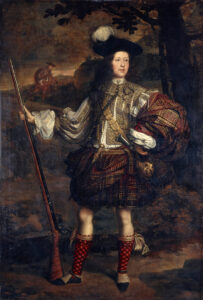
Launching the exhibition, Leonie Bell, V&A Dundee Director, hinted at the breadth of subjects that will be covered, saying: “Everyone knows tartan, in Scotland and across the world, and it is linked to a hugely diverse range of identities. It is the pattern of Highland myth and legend, forever entwined with Bonnie Prince Charlie and the Jacobite uprising, and the pattern of 1970s punks and contemporary Japanese fashion influencers.”
Among the many aspects covered in the exhibition, will be how tartan has been worn throughout history. A fragment of tartan worn by Bonnie Prince Charlie (now considered a national relic) will be on display, as will an 18th-century dress coat from the Ancient Caledonian Society (pictured above), and a photo taken in 1908 showing Scottish Suffragettes wearing tartan sashes. The exhibition will also look at tartan as a symbol of Scottish identity and how important it has become to the Scottish diaspora.
But what are the origins of tartan and how did it rise to become a symbol of Scotland whose popularity endures to this day?
I spoke with Finlay Wilson, the V&A’s tartan ambassador, to find out more.
THE KILTED TARTAN EXPERT

Known to many as the Kilted Yogi, Finlay Wilson, who has amassed a huge following for his kilted yoga, often practised in natural and beautiful Scottish landscapes, may not be the obvious choice for a tartan ambassador, but a man who wears kilts pretty much every day is not to be underestimated.
Unbeknown to his legion of fans, Finlay has always been interested in Scottish history, and when he shared some of his tartan knowledge with his friends and colleagues at the V&A (Finlay often teaches yoga classes there) they knew he was the right man for the job.
The earliest tartan fragment in Scotland, Finlay tells me, dates from the 3rd century and was found along the Antonine Wall, near Falkirk, and is now kept at the National Museum of Scotland in Edinburgh.
Interestingly, he says, it appears to have been a covering or ‘closer’ for a jar. He says: “You can see the patterns of lines and they would have been made using whatever natural ores or plants were found in that area.”
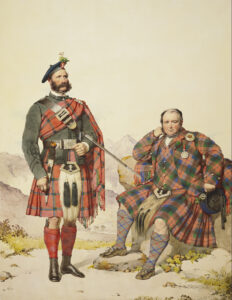
In this way, Finlay says, tartan was often a geographical statement for anyone wearing it. Some believe that the number of lines in a pattern denoted social class, but Finlay says there is little evidence to support this.
Further investigation takes me to an article in The Scotsman, which says this particular tartan covering was actually used as a stopper for a jar containing around 1,900 Roman coins.
The article quotes Dr Hunter of National Museums of Scotland who said that checked material of this kind was ‘fairly common” throughout Northern Europe at the time.
Though we know Scottish clans wore plaids or kilts made of tartan and that the Jacobites had their own tartan, which became a symbol of national identity, the idea of specific tartans linked to specific clans is a relatively modern idea.
In fact, we don’t know an awful lot about clan tartan until the 19th century, and it’s this era of history that has given Finlay another reason for delving into the evolution of tartan in Scotland.
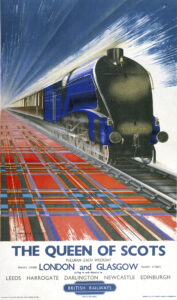
When King George IV made his famous visit to Scotland in 1822, carefully orchestrated by the newly knighted Sir Walter Scott, in which he was heavily clad in tartan, members of the Wilson clan dressed him for the occasion, though Finlay says he has found no direct family link.
Still, it interests and amuses him that it was a family of merchant weavers by the name of Wilson, who hailed from Bannockburn, Stirling that had begun supplying Highland regiments with tartan in the 18th century, and who chronicled lots of the early tartan designs.
Setting up shop in Edinburgh in the early 19th century, these Wilsons began compiling a list of the surviving clan tartans in their Key Pattern Book, published in 1819. Finlay says the idea that specific clan tartans date back centuries and centuries is more based in folklore than fact and it’s more likely that the Wilsons offered up their own interpretations of designs, and when clan chiefs were encouraged to visit the king wearing their clan tartan, they would visit the Wilsons and say, “this one is nice, we’ll take this one.”
But while George IV and his pal Sir Walter Scott may well have reignited an interest in Scottish clans and traditions, it’s clear that tartan was important to Highland culture long before this. “It was significant enough to the rebels to make the Crown want to ban it to quash an identity”, Finlay says, referring to the Dress Act 1746 (part of the Act of Proscription), which forbade Highland dress after the Jacobite risings and Culloden.
But what is it about tartan that has ensured it’s endured since? Finlay thinks it could be down to the versatility of its design: “You can change any element of it, from where the lines are, to rotating the sett so it’s on the diagonal, and create a type of tartan that’s unique,” he says.
Finlay knows first-hand how one-of-a-kind tartans are created, as he visited Prickly Thistle – the only tartan weaving mill in the Highlands – to see how his own Kilted Yoga tartan was created.
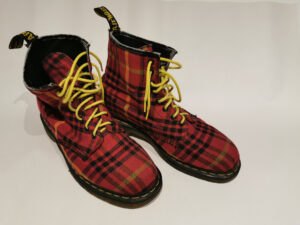
“There’s a lot to factor in – the colour, when the pattern repeats, how the pattern repeats,” he says. But he’s pleased to have patented his own tartan, which is now on the official Scottish Register of Tartans. The design is like a homage to him and his twin brother Alastair, with the white cross representing the birth of the pair (something he likes to rib his other brothers about when they wear it).
It also offers a sense of inclusion to some of his many followers: “My yoga teaching appeals to a lot of the LGBT+ community and for many of them, family can be a contentious issue, so it’s nice to be able to welcome them into our family,” he says.
The V&A Dundee has also commissioned its own tartan for the exhibition, designed by Kinloch Anderson, around which a range of merchandise will be developed, and in The People’s Tartan section of the exhibition, a collection of objects loaned to the exhibition by members of the public is sure to spark nostalgia among those who visit.
In terms of tartan’s usage throughout history, Finlay says the exhibition also looks at murkier associations: “Very bravely, there’s a dark side explored,” he says. “They look at the way tartan was used as a uniform for enslaved people in the colonies – they’re not holding back from that.”
And then of course, the exhibition explores how tartan has been used of an act of rebellion, in history and fashion (enter Westwood, her punk peers and later contemporaries).
Mhairi Maxwell, a curator at V&A Dundee, says: “Tartan is a design which offers a set of rules to be disrupted. The sett, warp, weft, and pivot are what makes tartan’s grid instantly recognisable, even the smallest fragment. But these rules are open to infinite possibility, as experimented with by designers in fashion, technology, architecture, and many other disciplines.”
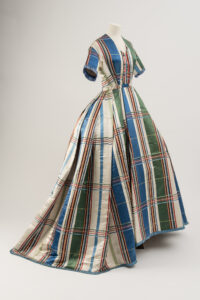
The exhibition will also touch upon tartan’s future as a sustainable fabric. Finlay says: “Tartan should be hardwearing – not synthetic – and modified and passed down through the years. Most boys’ first kilts are their dad’s kilt, or their grandad’s kilt, or their big brother’s kilt. The cost is prohibitive because it is built to last.”
But how does the modern man wear his kilt? Usually kilts are worn at special occasions, such as weddings. “When you show up in clan colours you are representing the family,” Finlay says, “my partner and I make sure never to wear our sgian dubhs [small knives often worn with kilts as part of Highland dress – ed] to weddings, as they are associated with clan warfare.”
Finlay says it’s unusual for someone to wear the tartan of a clan they are not associated with but there are lots of non-clan associated tartans. To find your clan’s tartan, go to the Scottish Register of Tartans (tartanregister.gov.uk).
The V&A’s Tartan exhibition will be complemented by the upcoming Tartan Week celebrations in the US which celebrates its 25th anniversary this year. It seems like tartan is, quite rightly, finally having its day.
For more on the V&A’s exhibition, go to vam.ac.uk/dundee/exhibitions/tartan
This is an extract. Read the full feature in the March/April 2023 issue of Scotland, available to buy from Friday 17 February.

SCOTLAND MAGAZINE
Published six times a year, every issue of Scotland showcases its stunning landscapes and natural beauty, and delves deep into Scottish history. From mysterious clans and famous Scots (both past and present), to the hidden histories of the country’s greatest castles and houses, Scotland‘s pages brim with the soul and secrets of the country.
Scotland magazine captures the spirit of this wild and wonderful nation, explores its history and heritage and recommends great places to visit, so you feel at home here, wherever you are in the world.
